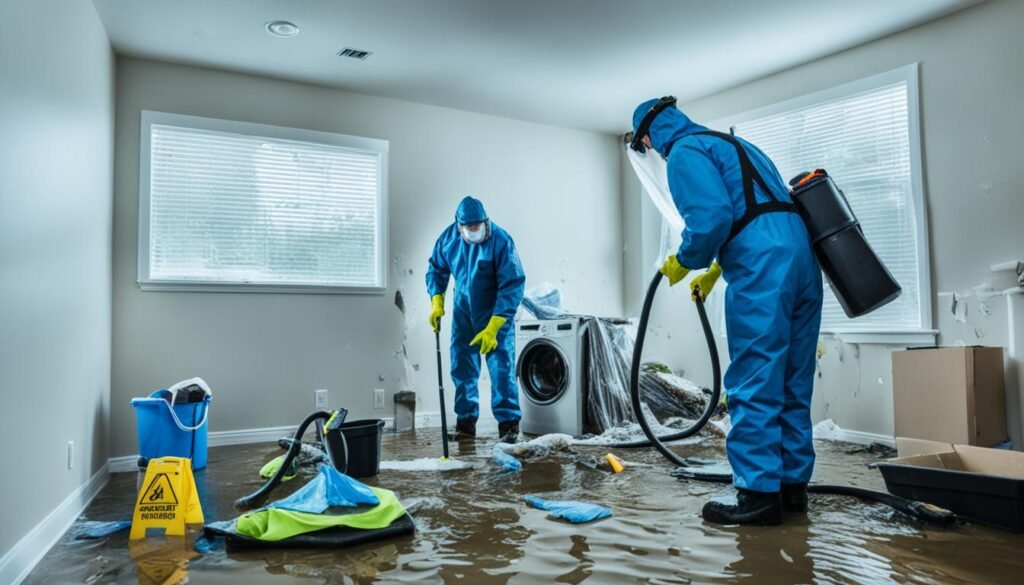Mold can start to grow fast, in just 24 to 48 hours after things get wet. Floods make the risk of mold in your house even higher. Mold is not good for our health. To stop mold before it starts, you need to keep things dry quickly. We’ll show you important tips for cleaning up after a flood. These tips will help keep your home safe.
Key Takeaways:
- Water damage after a flood can quickly lead to mold growth, which poses significant health risks.
- Mold colonies can start growing within 24 to 48 hours of water exposure and continue to grow as long as moisture levels are high.
- To prevent mold after flooding, it is crucial to dry the affected area quickly by opening up the building for air circulation, removing debris and wet items, cleaning exposed surfaces with disinfectants, and using fans and dehumidifiers.
- Knowing when to seek professional help for mold remediation is essential, especially in cases of significant flood damage or uncertain scope of the project.
- When cleaning up flood damage, always prioritize your safety and use appropriate protective equipment.
Steps to Prevent Mold After a Flood
After a flood, acting fast is key to stop mold in your home. Mold brings health risks and can harm your property. Use these steps to fight mold after flooding:
- Emergency Water Removal: Start by getting rid of standing water. Use wet/dry vacuums or pumps. This lowers moisture and stops mold.
- DIY Water Damage Repair: Check the water damage level. Decide if you can fix leaks or damages yourself. Quickly repair to avoid more moisture and mold.
- Flood Cleanup Checklist: Make a detailed checklist for cleanup. It should list removing debris, drying items, cleaning surfaces, and tossing damaged stuff. A checklist keeps you organized.
- Flood Cleanup Services: For severe damage, hire cleanup professionals. They are experienced in water damage and mold prevention.
- Home Flood Cleanup: Dry your home well after a flood. Open windows and doors. Use fans, dehumidifiers, and towels to dry out moisture.
Quickly removing water and drying areas cuts mold risk. If unsure about damage or needing mold help, get professional advice.
DIY Flood Cleanup vs. Professional Flood Cleanup Services
| DIY Flood Cleanup | Professional Flood Cleanup Services | |
|---|---|---|
| Expertise | Needs basic water damage and mold knowledge | Professionals have deep knowledge and experience |
| Equipment | Common household tools, fans, and dehumidifiers | Professionals use high-grade fans, dehumidifiers, and tools |
| Time | DIY might take longer | Professionals work quickly, reducing mold risk |
| Results | Can work well if done right | Gives thorough cleanup and mold prevention |
To fight mold after flooding, act fast and choose between DIY or professional cleanup. Ensure your home is dry to protect your family’s health.
Conclusion
DIY flood cleanup helps stop mold from growing after a flood. You can get rid of standing water, dry areas, and cut mold risks by following our tips. Acting fast and smart helps avoid more damage and keeps your home safe.
If you’re not sure about the flood’s impact or it looks big, get a pro. Mold experts have the right tools and know-how to tackle major mold issues. They ensure your home gets fully restored.
Your safety comes first in DIY water damage repair. Wear the right gear and take care of yourself. Quick action and the right steps can lessen flood damage. This lets you get your home back to how it was before the flood.


